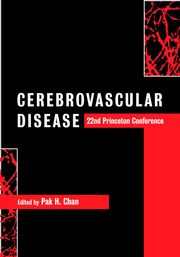Book contents
- Frontmatter
- Contents
- List of contributors
- Preface
- Acknowledgments
- Part I Special lectures
- Part II Oxidative stress
- Part III Apoptosis
- 7 Cell death programs in neural development and disease
- 8 Apoptotic gene expression in brain ischemia and ischemic tolerance
- 9 Cellular mechanisms of white matter ischemia: what can we learn from culture models?
- Part IV Hot topics
- Part V Hemorrhage, edema and secondary injury
- Part VI Inflammation
- Part VII Gene transfer and therapy
- Part VIII Neurogenesis and plasticity
- Part IX Magnetic resonance imaging in clinical stroke
- Part X Risk factors, clinical trials and new therapeutic horizons
- Index
- Plate section
9 - Cellular mechanisms of white matter ischemia: what can we learn from culture models?
from Part III - Apoptosis
Published online by Cambridge University Press: 02 November 2009
- Frontmatter
- Contents
- List of contributors
- Preface
- Acknowledgments
- Part I Special lectures
- Part II Oxidative stress
- Part III Apoptosis
- 7 Cell death programs in neural development and disease
- 8 Apoptotic gene expression in brain ischemia and ischemic tolerance
- 9 Cellular mechanisms of white matter ischemia: what can we learn from culture models?
- Part IV Hot topics
- Part V Hemorrhage, edema and secondary injury
- Part VI Inflammation
- Part VII Gene transfer and therapy
- Part VIII Neurogenesis and plasticity
- Part IX Magnetic resonance imaging in clinical stroke
- Part X Risk factors, clinical trials and new therapeutic horizons
- Index
- Plate section
Summary
Introduction
Ischemic brain disease is a serious cause of neurological disability, with profound social and economic consequences. Ischemic strokes in large-vessel territories damage both gray and white matter. In addition, white matter may be preferentially injured by infarcts in the distribution of small penetrating arteries. The pathophysiology of hypoxic–ischemic injury of white matter can be expected to have unique features in comparison to gray matter because white matter contains no synapses or neuronal soma, but instead has myelinated axons and oligodendrocytes. One of the important lessons learned is that energy deprivation engages different mechanisms of injury in glial cells as compared with neuronal cell bodies or axonal processes. A detailed understanding of the mechanisms of central nervous system white matter injury would be of central importance in designing more effective neuroprotective and therapeutic strategies for this injury. To fully protect brain function against anoxia/ischemia, it is necessary to preserve the functional integrity of white matter as well as gray matter. Surviving neuronal populations whose axonal connections have been destroyed or disabled would be functionally useless.
Although white matter is most often severely affected in human stroke, studies of rodent stroke models rarely note white matter injury. In part this is because a considerably smaller proportion of the mouse or rat brain comprise white matter. The mature human brain is approximately 50% white matter whereas far less of the rodent brain is white matter.
- Type
- Chapter
- Information
- Cerebrovascular Disease22nd Princeton Conference, pp. 95 - 110Publisher: Cambridge University PressPrint publication year: 2002
- 1
- Cited by



